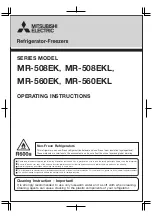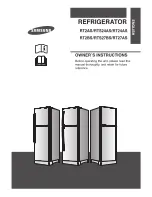
4. Operation
Temperature Control of
the Refrigerator Compartment
Temperature Control of
the Freezer Compartment
6
2. Automatic Defrosting
3. Ice-making
1. Temperature Control
Both the freezer compartment and the refrigerator
compartment have a temperature control.
“MID” is recommended for normal usage.
Turn the dial to “COLDER” when storing a large quantity
of frozen foods, ice cream etc., in the freezer compartment.
Turn the dial to “FREEZER” when only using
the freezer compartment to make ice.
“MID” is recommended for normal usage.
If you would like items in the refrigerator
compartment to be colder, turn the dial to “COLDER”.
If the items are too cold or freeze in the refrigerator
compartment, turn the dial to “REFRIGERATOR”.
Pour water up to the water line in each of the ice tray sections.
Insert the tray completely into the ice tray holder.
If too much water is added, the ice cubes cannot be
easily separated from the ice tray.
Once the ice cubes have been made, turn the lever until
they fall into the ice cube storage box.
If you attempt to make ice directly in the ice cube
storage box, the box will break.
The defrosting heater provides automatic defrosting in the refrigerator according to the accumulated time
calculated by the microcomputer,
so there is no need to defrost it manually. Water produced during defrosting passes through the drainage
hose at the rear and collects in the drain pan in the lower rear part of the refrigerator. Then, it automatically
evaporates with heat from the refrigerant pipe, which is utilized as a radiator.
Fig. 1
Fig. 2
Sliding case
Open by pulling the case out.
Lid
CAUTION:
Before closing the refrigerator compartment door,
make sure that the sliding case is pushed
all the way in (and the lid is closed correctly).
This sliding case is cooled to a low temperature in order
to preserve the freshness of foods stored for long periods.
4. Sliding Case
Remove the lid and sliding case as shown in
the illustration and proceed with cleaning.
Pull the case out. Open the lid and then pull out
holding the right and left hand sides (Fig. 1).
Pull the case out all the way. Pull out by holding
and lifting the edge of the case upwards (Fig. 2).
Fig. 1
Fig. 2
Fig. 3
The door racks may be used to store all those little items that seem to get in the way. If you put all the
small items in one place, you’ll find that there’s more space inside the refrigerator for larger items.
5. Door Racks
Many eggs may be stored in the free pocket (Fig. 1).
If you turn half the egg tray over, small items may be stored together with the eggs (Fig. 2).
You can even turn the whole egg tray over and store small items in the free pocket instead of eggs (Fig. 3).
Free Pocket with Egg Tray






























